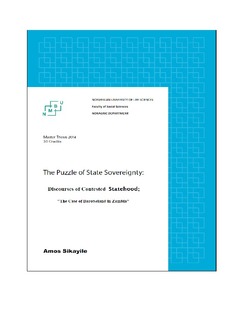| dc.contributor.author | Sikayile, Amos | |
| dc.date.accessioned | 2015-03-02T11:54:07Z | |
| dc.date.available | 2015-03-02T11:54:07Z | |
| dc.date.copyright | 2014 | |
| dc.date.issued | 2015-03-02 | |
| dc.identifier.uri | http://hdl.handle.net/11250/278123 | |
| dc.description.abstract | This thesis seeks to engage with the contested explanations as to why and how the
Barotseland question keeps on re-emerging in Zambia while a peaceful solution remains
elusive. It does so by analysing factors which account for its continuity since 1964 when the Barotseland Agreement, which unified two separate entities, namely Barotseland and
Northern Rhodesia (thereby creating a unitary state called Zambia) was ratified but only to be prematurely and unilaterally terminated by the government in 1967. Over the years,
Barotseland’s traditional elites have presented several petitions to the state to have the
agreement restored, but the futility of a peaceful settlement continues to loom large, sparking separatist demands. Therefore, chapter one establishes how the Barotseland question invokes IR’s highly contested notion of state sovereignty since it challenges the very conventional
interpretation of Zambia’s postcolonial state sovereignty. The second chapter historicises the Barotseland question by tracing its origin as well as mapping actors involved in the conflict. It also highlights the trajectories in time and space pertaining to the region’s quest for sovereignty, emanating from its precolonial autonomous status which apparently was
enshrined in the 1964 agreement which was abrogated. Chapter three theorises state
sovereignty by examining how the domestication of its problematic international norms or
principles singled out by recent scholarship impedes rather than bolsters separatist
movements. Notwithstanding the theoretical underpinnings of sovereignty as regards to the debate about redrawing Africa‘s bizarre borders or maintaining the status quo, chapter three investigates the literature on the Barotseland question in order to determine the extent to which alternative explanations beyond the modernist arguments about separatism need to be reconsidered. In so doing, Barotseland’s sovereignty perils are discussed in the context of the region’s peripheral outlook alongside politics of neopatrimonialism and state patronage, all of which instrumentalise the continuity of the Barotseland question. The findings and analytical discussion in chapters four and five respectively justify the argument presented in chapter one. By its nature, the Barotseland question is simply separatism as an alias (rather, a political necessity) premised on Zambia’s juridical statehood which lends for Barotseland’s political elites’ in-group domination and contradictory national logic of resource appropriation for
personal gain. Generally, this situation engenders the reproduction of the Zambian state and thus far negates its disintegration as promulgated by separatist groups who are seeking to free Barotseland. The thesis climaxes with concluding remarks which highlight among other issues practical recommendations with academic implications uncovered in the conclusion. | nb_NO |
| dc.language.iso | eng | nb_NO |
| dc.publisher | Norwegian University of Life Sciences, Ås | |
| dc.rights | Attribution-NonCommercial-NoDerivs 3.0 Norway | * |
| dc.rights.uri | http://creativecommons.org/licenses/by-nc-nd/3.0/no/ | * |
| dc.subject | VDP::Samfunnsvitenskap: 200 | nb_NO |
| dc.subject | VDP::Samfunnsvitenskap: 200::Statsvitenskap og organisasjonsteori: 240::Internasjonal politikk: 243 | nb_NO |
| dc.title | The puzzle of state sovereignty; discourses of contested statehood - "The case of Barotseland in Zambia" | nb_NO |
| dc.type | Master thesis | nb_NO |
| dc.source.pagenumber | 104 | nb_NO |
| dc.description.localcode | M-IES | |

